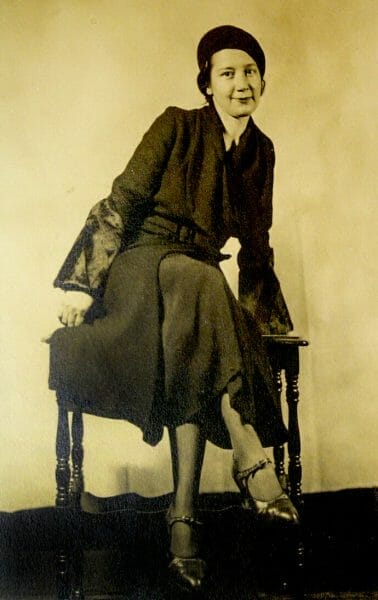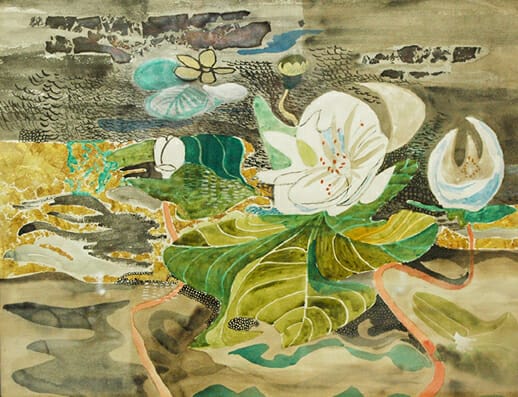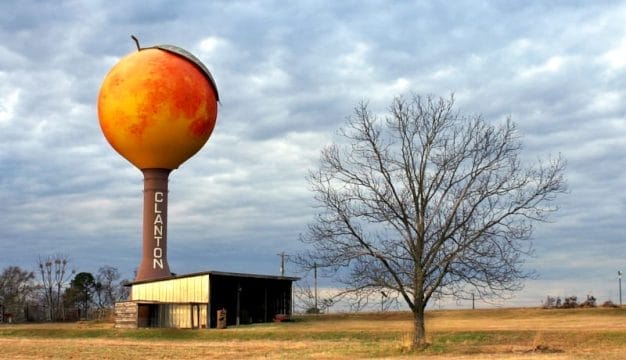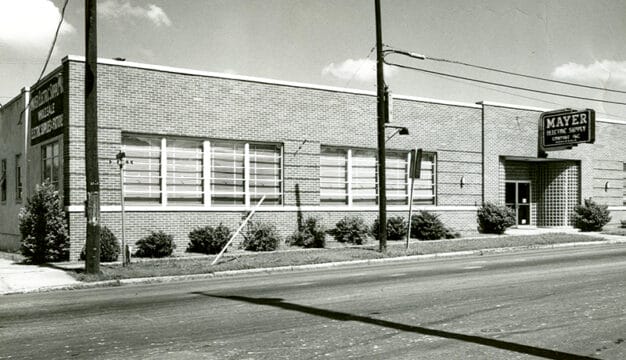Lois Wilson
 Lois Wilson
Lois Wilson (1905-1980) was an artist from west Alabama whose most distinctive artworks fit into the folk, primitive, or “outsider” art genres. Despite considerable schooling and training in Boston and New York City, much of her art prefigured the popular self-trained outsider art movement of the 1980s and 1990s. She did not, however, achieve similar fame, unlike her fellow Fayette County resident Jimmy Lee Sudduth. That she was southern, white, poor, a religious visionary, and adept at using scavenged materials for her work, also set her apart from trained artists. Her artworks included such things as ironing boards, toilet seats, and the backs of dresser drawers. Her subjects included a variety of faces and figures, often poor people around her, as well as her religious visions and charts.
Lois Wilson
Lois Wilson (1905-1980) was an artist from west Alabama whose most distinctive artworks fit into the folk, primitive, or “outsider” art genres. Despite considerable schooling and training in Boston and New York City, much of her art prefigured the popular self-trained outsider art movement of the 1980s and 1990s. She did not, however, achieve similar fame, unlike her fellow Fayette County resident Jimmy Lee Sudduth. That she was southern, white, poor, a religious visionary, and adept at using scavenged materials for her work, also set her apart from trained artists. Her artworks included such things as ironing boards, toilet seats, and the backs of dresser drawers. Her subjects included a variety of faces and figures, often poor people around her, as well as her religious visions and charts.
Lois Lecille Wilson was born January 14, 1905, in rural Lamar County to Lee Wilson, a poor farmer and blacksmith, and his wife, Mellie Shelton Wilson; she was one of three children. As a child, Wilson was interested in drawing and painting, using shoe polish on scrap tin for her designs. She finished grammar school and high school in Fayette, Fayette County, where she was remembered as being smart, but a loner. She worked during high school to supplement her family’s income and later painted houses. In 1921, after finishing the eighth grade, she dropped out of school for five months and taught at Hubbertsville School in northern Fayette County. She then returned to school and resumed her studies and graduated in 1924 with her class, which voted her “Smartest Girl.” Her caricature drawings of high school teachers were published in the Fayette Banner on February 21, 1924.
Wilson received a Birmingham News scholarship for bright but impoverished students to Alabama Polytechnic Institute (present-day Auburn University) to study architecture. She stayed one year and being extremely poor was unable to pay to travel home, even at Christmas, and scrounged for leftover soap in the showers. Likely through one of her professors at API, Wilson heard about the Child-Walker School of Design in Boston and applied for a scholarship there. She was accepted and essentially left Alabama forever.
At the Child-Walker School, Wilson honed her artistic skills, particularly in watercolor painting. After her scholarship expired, she stayed in Boston for several years, working at an art-supply store and a doctor’s office. Her younger sister Ruth moved to Boston in the late 1920s. Animosity between the sisters meant that Lois began spending increasing time in New York, though she continued to use Boston as an address until she moved permanently to New York in the mid-1930s. In 1930, a wealthy New York friend paid for a two-month trip to France and Italy, where Wilson painted at least a dozen very accomplished watercolors.
 Waterlilies
The Great Depression years of the 1930s were bleak for Wilson and for the country in general. After returning from Europe, she lived for a while in Greenwich Village in New York City, and by the mid-1930s had moved to Yonkers, New York, for cheaper rent. She regarded 1935, during which a friend died by suicide, as a turning point in her life. Wilson felt so despondent that she might have followed suit had it not been her discovery of a psychic who practiced a mystic spiritualism. Wilson was convinced he saved her life. Later, in the 1950s, her spiritualism attracted her to the radio sermons of the Foundation Church of the New Birth. This religion was headed by self-proclaimed prophet J. E. Padgett, who preached of the existence of a multilevel spirit world and communication with the dead. Wilson became increasingly immersed in it as she got older, and it inspired many of her late art works. Despite her poverty, she scorned what she deemed the “government handout” of federal aid programs like Works Progress Administration, which hired artists to travel around the country and document the hardships of the Depression. She considered those artists who did participate “snobs.”
Waterlilies
The Great Depression years of the 1930s were bleak for Wilson and for the country in general. After returning from Europe, she lived for a while in Greenwich Village in New York City, and by the mid-1930s had moved to Yonkers, New York, for cheaper rent. She regarded 1935, during which a friend died by suicide, as a turning point in her life. Wilson felt so despondent that she might have followed suit had it not been her discovery of a psychic who practiced a mystic spiritualism. Wilson was convinced he saved her life. Later, in the 1950s, her spiritualism attracted her to the radio sermons of the Foundation Church of the New Birth. This religion was headed by self-proclaimed prophet J. E. Padgett, who preached of the existence of a multilevel spirit world and communication with the dead. Wilson became increasingly immersed in it as she got older, and it inspired many of her late art works. Despite her poverty, she scorned what she deemed the “government handout” of federal aid programs like Works Progress Administration, which hired artists to travel around the country and document the hardships of the Depression. She considered those artists who did participate “snobs.”
During World War II, Wilson went to work in the war effort. She helped install the “skin,” or thin outer metal covering, on U.S. Navy bombers built by General Motors at Eastern Aircraft in Tarrytown, New York. In 1944, she joined the Women’s Army Corps (WACs). Her job in the WACs also involved working at a psychiatric hospital in Plattsburgh, New York, where she met and married Mel Croson, an abusive alcoholic. The marriage was brief.
 Hinged Pieces
Because of her military service, Wilson qualified for education benefits under the GI Bill and began the happiest period in her life. From 1949-52, she attended the Art Students League in New York. She received in-depth training in all the latest trends in the art world and made several artist friends whom she retained for many years. When her benefits expired, Wilson worked at a variety of jobs, such as factory worker, draftsperson, gallery attendant, and salesgirl, to make a living. But she considered herself first and foremost an artist at heart and often used her work life as inspiration for her art life. At this time, she began to turn toward creating collages with found objects.
Hinged Pieces
Because of her military service, Wilson qualified for education benefits under the GI Bill and began the happiest period in her life. From 1949-52, she attended the Art Students League in New York. She received in-depth training in all the latest trends in the art world and made several artist friends whom she retained for many years. When her benefits expired, Wilson worked at a variety of jobs, such as factory worker, draftsperson, gallery attendant, and salesgirl, to make a living. But she considered herself first and foremost an artist at heart and often used her work life as inspiration for her art life. At this time, she began to turn toward creating collages with found objects.
Wilson had always lived frugally, so her $100-a-month Social Security check was enough to sustain her when she retired in 1963. When urban renewal began to demolish parts of her neighborhood, she found a treasure trove of wood and other materials that became the basis of an expanded and new phase in her artwork, using scavenged materials as canvases. Her religious beliefs and her social consciousness regarding the poor, as well as environmental conservation issues provided potent subject matter. Though she was practicing this type of art too early to catch the “outsider wave,” she did see herself as part of the folk and primitive art appreciation fostered by the upcoming American Bicentennial.
 Happy Face
When her Yonkers apartment began filling up with hundreds of new pieces, she began to consider what would become of her collections when she died. She knew her distant family had no appreciation of her art, but she hoped to interest her hometown of Fayette in it. At this time, aesthetically astute citizens in Fayette were looking for ways to improve the cultural offerings of their town. Among these were Jack Black, who ran the newspaper and radio station; Wilson’s former teacher, Ann Hoffman Gullett; and local artist, Peggy McGuire. Wilson had been in contact with Gullett and then began to correspond with Black and McGuire who ultimately led the effort beginning in 1969 to have most of her art delivered from Yonkers to Fayette. There, it became the nucleus of what is now the Fayette Art Museum and Civic Center.
Happy Face
When her Yonkers apartment began filling up with hundreds of new pieces, she began to consider what would become of her collections when she died. She knew her distant family had no appreciation of her art, but she hoped to interest her hometown of Fayette in it. At this time, aesthetically astute citizens in Fayette were looking for ways to improve the cultural offerings of their town. Among these were Jack Black, who ran the newspaper and radio station; Wilson’s former teacher, Ann Hoffman Gullett; and local artist, Peggy McGuire. Wilson had been in contact with Gullett and then began to correspond with Black and McGuire who ultimately led the effort beginning in 1969 to have most of her art delivered from Yonkers to Fayette. There, it became the nucleus of what is now the Fayette Art Museum and Civic Center.
A heavy smoker most of her life, Wilson had advancing emphysema by the mid-1970s. She could no longer work and was in and out of hospitals and nursing homes until her death on September 19, 1980. Her sister Ruth had her cremated and the ashes sent to Fayette to be buried beside her mother and father in Fayette City Cemetery.
Interest in Lois Wilson and her work has increased since her death. She has been featured in several exhibitions and lectures, and a feature film by Fayette-born Alexandra Branyon, Treasures from the Rubble, premiered in 2012. Her work remains the focal point of an ongoing exhibit at the Fayette Art Museum.
Further Reading
- Thomson, Laquita. “Lois Wilson: An Outsider Before Her Time.” Alabama Heritage 120 (Spring 2016): 22-31.
- Treasures from the Rubble. Directed by Alexandra Branyon. Tuscaloosa, Ala.: Alabama Center for Public Television, 2013. Video.


